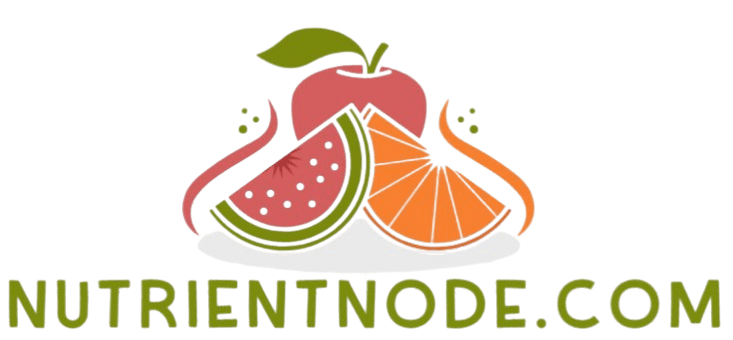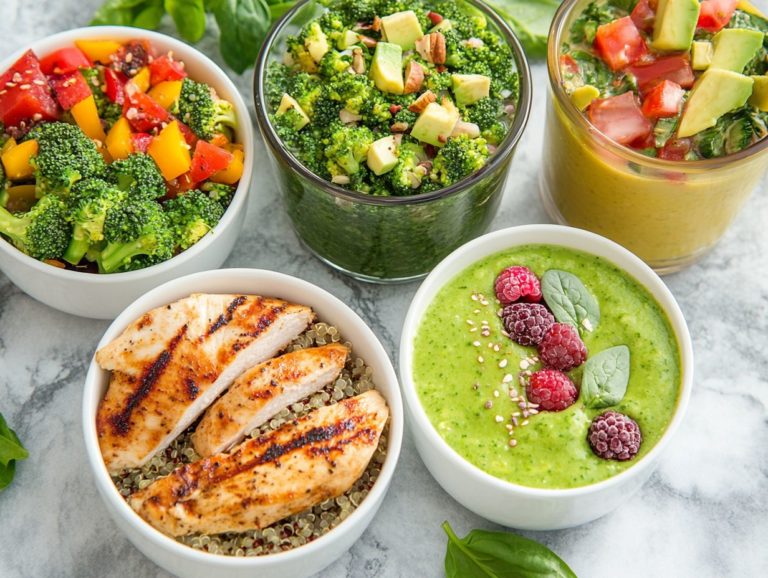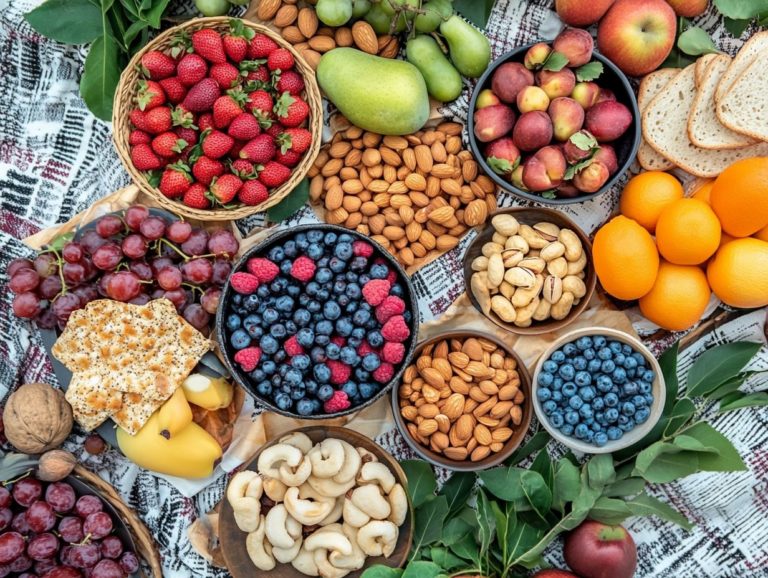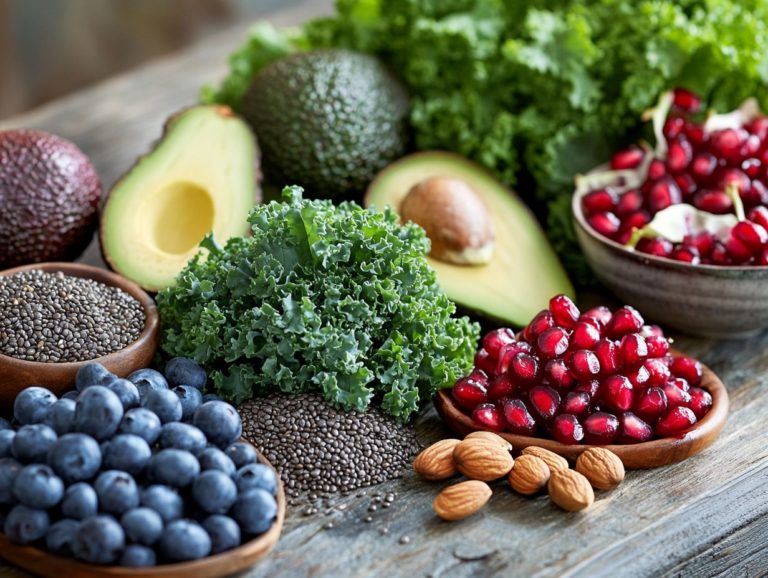Understanding Food Cravings: What to Do
Food cravings can be incredibly strong, pulling you towards your favorite snacks. But what exactly are they, and what causes them?
This article unpacks the definition of food cravings. It delves into common triggers and helps you distinguish between physical and emotional urges. You ll explore the science behind how your brain and body respond. Discover effective strategies to manage those cravings, and find healthier alternatives to satisfy your desires.
We will also discuss signs that indicate you might need professional help. Whether you aim to understand your cravings better or are looking for practical ways to manage them, this guide has everything you need.
Contents
- Key Takeaways:
- What are Food Cravings?
- Types of Food Cravings
- The Science Behind Food Cravings
- Managing Food Cravings
- Healthy Alternatives to Satisfy Cravings
- Seeking Professional Help
- Frequently Asked Questions
- What are food cravings and why do we experience them?
- How can I differentiate between cravings and true hunger?
- What are some common triggers for food cravings?
- Is it okay to give in to food cravings?
- How can I manage and reduce my food cravings?
- When should I seek professional help for my food cravings?
Key Takeaways:

Understand the difference between physical and emotional cravings. Learn common triggers to help manage them.
Become aware of the science behind food cravings, including how the brain and body react, to better understand and manage them.
Explore healthy alternatives to satisfy cravings, such as nutritious options for common cravings, and consider seeking professional help if necessary.
What are Food Cravings?
Food cravings are those powerful, specific urges you experience for certain types of foods. They often draw you towards ultra-processed options like salty, sweet, or crunchy snacks.
These cravings are influenced by a mix of external cues from your social surroundings and internal signals stemming from poor sleep or emotional states. Grasping the nature of food cravings is crucial for tackling emotional eating and nutritional deficiencies. It’s also important for sustaining a well-rounded diet.
Experts, including Erin Morse, a chief clinical dietitian at UCLA Health, emphasize the importance of this understanding in your journey toward healthier eating habits.
Definition and Common Triggers
Food cravings are those intense urges you experience to indulge in specific types of food. They are often ignited by a blend of external triggers think advertisements and internal factors, such as emotional states like stress or fatigue.
You might notice these cravings surfacing during particularly stressful moments. You may find yourself seeking solace in familiar, often less-than-healthy choices after a long day when your energy reserves are running low.
Environmental cues, like the alluring scent of freshly baked goods or the sight of enticing fast food, can amplify these desires. This makes it increasingly challenging to resist temptation.
Your body s physiological needs, such as nutrient deficiencies, can also play a significant role. They can send signals that prompt cravings for particular foods like carbohydrates for a much-needed energy boost or sweets to lift your mood.
This intricate dance between emotions, surroundings, and bodily signals is what makes cravings both perplexing and difficult to manage.
Types of Food Cravings
You can broadly categorize food cravings into two types: physical cravings, which stem from your biological needs, and emotional cravings, often tied to psychological symptoms or stress.
These cravings frequently present themselves as a longing for foods that taste amazing and are hard to resist. They are often cleverly engineered delights that activate your brain’s reward pathways, making them incredibly tempting and difficult to resist.
Physical and Emotional Cravings
Physical cravings often arise from intricate biological mechanisms involving hormones such as leptin and ghrelin. Emotional cravings are rooted in psychological factors, including dopamine responses linked to food addiction.
These hormones are pivotal in regulating your appetite and energy balance. They send clear signals to your brain about when to eat and when to stop. Leptin, often dubbed the ‘satiety hormone,’ works to decrease your appetite when fat stores are sufficient. Ghrelin, known as the ‘hunger hormone,’ stirs up feelings of hunger.
On the psychological front, the allure of certain foods can trigger your brain’s reward system. This system releases dopamine and reinforces the behaviors associated with eating.
This powerful combination of biological drives and emotional triggers can create a compelling urge. It influences your food choices and leads you to seek comfort or pleasure through specific foods even when your body might not actually need them.
Now that you understand food cravings, it’s time to take control and make healthier choices!
The Science Behind Food Cravings

Food cravings involve complex interactions in our brain. They connect the brain’s reward pathways with stress responses.
Research shows that brain chemicals like dopamine and stress hormones such as cortisol play a crucial role in this phenomenon. The Yale Food Addiction Scale outlines this relationship, highlighting how deeply rooted these cravings are in our biology.
How the Brain and Body React
When you experience food cravings, your brain’s reward pathways light up, releasing dopamine. This chemical rush reinforces your desire for those tempting foods.
At the same time, stress hormones like cortisol can increase emotional eating. This creates a feedback loop that makes managing cravings feel like an uphill battle.
As cravings intensify, you may notice a rise in ghrelin, a hormone that signals hunger. This complex interaction between brain chemicals and hormones shapes your eating behaviors, making it tough to resist high-calorie treats.
Additionally, serotonin known for its mood-regulating role can dip during restricted eating times. This drop nudges you toward comfort foods to lift your spirits. Understanding this biological response empowers you to take control and make healthier choices!
Managing Food Cravings
Managing food cravings requires a thoughtful approach, going beyond just willpower. It’s essential to understand what triggers these cravings and implement effective strategies to curb unhealthy eating habits.
By focusing on hydration, sleep quality, and including nutritious snacks, you can skillfully navigate cravings. This helps avoid falling into emotional eating or making poor dietary choices.
Strategies for Overcoming Cravings
- Stay hydrated.
- Choose healthy snacks.
- Embrace dietary patterns like the Mediterranean diet.
These foundational practices can help balance your nutrition and reduce the chances of emotional eating. Mindfulness techniques are also crucial for identifying emotional triggers behind cravings.
Engaging in mindful eating fosters a deeper awareness of your hunger cues, allowing for healthier decisions.
Incorporating regular physical activity, even in small increments, can improve your mood and reduce stress two factors often linked to cravings. Seeking support from a community or working with a nutritionist can provide the encouragement and accountability you need.
This reinforces your commitment to a balanced approach to food, free from guilt or deprivation.
Healthy Alternatives to Satisfy Cravings
Try tasty, healthy alternatives to satisfy your cravings while nourishing your body. Options like Greek yogurt, a piece of rich dark chocolate, and herbal tea deliver delightful flavors that align perfectly with a balanced diet, especially within the Mediterranean diet framework.
These nutrient-dense choices elevate your snacking experience, providing both satisfaction and health benefits.
Nutritious Options for Common Cravings

For common cravings, consider nutritious options like Greek yogurt or a small piece of rich dark chocolate. These choices satisfy your sweet tooth without the pitfalls of sugar overload, helping maintain a balanced nutrient intake.
You have many other delightful options that boost your wellness. If you crave something savory, nuts like almonds or walnuts are ideal. They provide healthy fats and protein, delivering that satisfying crunch you crave.
On the sweeter side, fresh fruits like apples or berries can effectively quell sweet cravings. Their fiber and antioxidants support immune health.
If you’re in the mood for something more substantial, pairing hummus with crunchy vegetables enhances flavor and supplies essential vitamins and minerals, making it a superb choice for a well-rounded diet.
View cravings as manageable, not burdensome. Embrace the journey to healthier eating!
Seeking Professional Help
When food cravings become overwhelming or lead to emotional eating and food addiction, it’s essential to seek help from a healthcare provider.
Professionals, like those at UCLA Health, provide valuable guidance in addressing the psychological aspects of eating and developing effective strategies for healthier habits.
When to Consult a Healthcare Provider
Consult a healthcare provider when food cravings are linked to emotional eating, food addiction, or persistent psychological symptoms disrupting daily life, as recommended by the American Psychiatric Association.
Signs may include guilt or shame after eating, an inability to control food intake despite wanting to stop, or using food to cope with stress or sadness.
Understanding the causes of these cravings is vital, as they often point to deeper mental health issues like anxiety or depression. By consulting a therapist or nutritionist, you can access tailored strategies to manage emotional triggers and improve overall well-being.
Addressing these cravings fosters a healthier relationship with food and enhances your quality of life.
Frequently Asked Questions
What are food cravings and why do we experience them?
Food cravings are intense desires for specific foods, often triggered by emotional or physical factors like stress, hormonal changes, or not getting enough vitamins and minerals. Our brain’s reward system also plays a role in creating these cravings.
How can I differentiate between cravings and true hunger?

Cravings often target specific foods, while true hunger is a general sense of needing to eat. Cravings can come on suddenly and can be satisfied with non-nutritious options. True hunger develops gradually and requires a balanced meal.
What are some common triggers for food cravings?
Common triggers include emotional factors like stress, boredom, or sadness. Hormonal changes during menstruation or pregnancy can also lead to cravings. Not getting enough essential minerals like magnesium or zinc can create strong desires for specific foods.
Is it okay to give in to food cravings?
It’s okay to indulge in food cravings occasionally, as long as you do so in moderation and practice mindful eating. Completely restricting certain foods can lead to binge eating and an unhealthy relationship with food. Pay attention to the frequency and intensity of your cravings to ensure they don’t negatively impact your health!
How can I manage and reduce my food cravings?
Managing and reducing cravings involves addressing underlying causes. This includes finding alternative ways to cope with emotions, correcting nutritional deficiencies, and practicing mindful eating. Listening to your body’s hunger and fullness cues can help prevent overeating and future cravings.
When should I seek professional help for my food cravings?
If your food cravings feel uncontrollable or affect your physical and mental well-being, it may be time to seek professional help. A healthcare provider or registered dietitian can help identify the root cause of your cravings and develop a personalized plan to manage them healthily.






